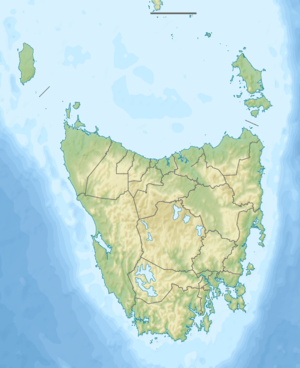Lemonthyme Power Station
The Lemonthyme Power Station is a conventional hydroelectric power station located in north-western Tasmania, Australia. It is the third station in the Mersey–Forth run-of-river scheme that comprises seven conventional hydroelectric power stations and one mini hydro station.
| Parangana Dam | |
|---|---|
 Location of the Parangana Dam in Tasmania | |
| Country | Australia |
| Location | North-western Tasmania |
| Coordinates | 41°37′48″S 146°13′12″E |
| Purpose | Power |
| Status | Operational |
| Opening date | 1968 |
| Owner(s) | Hydro Tasmania |
| Dam and spillways | |
| Type of dam | Embankment dam |
| Impounds | Mersey River |
| Height | 53 metres (174 ft) |
| Length | 189 metres (620 ft) |
| Dam volume | 382 thousand cubic metres (13.5×106 cu ft) |
| Spillways | 1 |
| Spillway type | Uncontrolled |
| Spillway capacity | 2,093 cubic metres per second (73,900 cu ft/s) |
| Reservoir | |
| Creates | Lake Parangana |
| Total capacity | 14,820 megalitres (523×106 cu ft) |
| Catchment area | 715 square kilometres (276 sq mi) |
| Surface area | 11.4 hectares (28 acres) |
| Lemonthyme Power Station | |
| Coordinates | 41°36′14″S 146°08′19″E |
| Operator(s) | Hydro Tasmania |
| Commission date | 1969 |
| Type | Conventional |
| Hydraulic head | 139 metres (456 ft) |
| Turbines | 1 x 54 MW (72,000 hp) Fuji Francis turbine |
| Installed capacity | 54 megawatts (72,000 hp) |
| Annual generation | 313 gigawatt-hours (1,130 TJ) |
| Website hydro | |
| [1] | |
Technical details
The Parangana Dam forms Lake Parangana by damming the Mersey River. Water from the lake is diverted west to Lemonthyme Power Station via a 6.5-kilometre (4.0 mi)-long tunnel, followed by a 1.6-kilometre (0.99 mi) single surface penstock.[2] The water then runs through the power station, and is discharged into the River Forth, then down to Lake Cethana.
The power station was commissioned in 1969 by the Hydro Electric Corporation (TAS). It has one Fuji Francis turbine, with a generating capacity of 54 megawatts (72,000 hp) of electricity. The station output, estimated to be 313 gigawatt-hours (1,130 TJ) annually, is fed to TasNetworks' transmission grid via two 3-phase 11 kV/220 kV Siemens generator transformers to the outdoor switchyard.[3]
Although much of the water from Lake Parangana travels the approximately 8 km to the Lemonthyme Power Station (which discharges into the River Forth), some water is allowed to continue down the Mersey River for environmental reasons, after running through the Parangana mini hydro station.
References
- "Register of Large Dams in Australia" (Excel (requires download)). Dams information. Australian National Committee on Large Dams. 2010. Retrieved 23 June 2015.
- "Mersey - Forth". Energy. Hydro Tasmania. Retrieved 3 July 2015.
- "Lemonthyme Power Station: Technical fact sheet" (PDF). Mersey-Forth Catchment. Hydro Tasmania. Archived from the original (PDF) on 24 March 2012. Retrieved 3 July 2015.